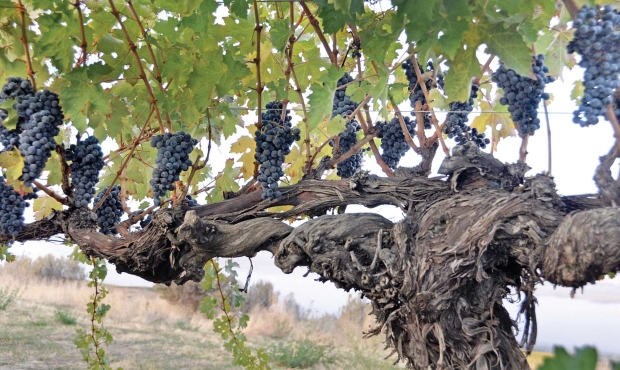
Some vines at Sagemoor Vineyards, such as this one, are more than 40 years old and still producing. (Courtesy Sagemoor Vineyards)
For nearly 30 years, Sagemoor Vineyards sold its grapes to one winery. Then it sold to seven different wineries, and today, more than 80, a transition that required a change in business models, hard work, and lots of people and management skills to deal with that many winemakers.
Kent Waliser’s first year as general manager of Sagemoor Farms and Vineyards in 2002 was also the first year that the Pasco, Washington, tree fruit and wine grape growing company began selling to more than one winery.
That first year, fruit from Sagemoor’s famed Bacchus Vineyard, an 11-acre block planted in 1972, was sold to seven wineries.
Sagemoor, founded in 1968, has some of the oldest large-scale wine grape plantings in Washington State. Several producing blocks are more than 40 years old and have no “pull date,” says Waliser. Fruit from Bacchus is sold on an acreage basis, with annual production varying from 2.5 to 3.5 tons per acre, depending on the winemaker.
In the early 2000s, most of the vineyard irrigation systems at Sagemoor were converted from overhead sprinklers to drip.
Bacchus Vineyard vines are spaced eight feet apart with ten feet between rows. Sagemoor Vineyards vines are located in a freeze-free zone where they have never required retraining from the ground up due to winter damage.
When vines are replaced, a propagation technique called layering is used in which a cane or shoot grows roots while still attached to the parent vine.
The shoot is trained up next to the parent and later detached to create a new, independent vine. Layering allows the new vine to feed off the parent while developing its own root system.
It’s no small feat to successfully overhaul a business strategy and cater to 80 different customers, many in the same small block.
Waliser shared his approach in changing the company’s business model and outlined key steps to successfully sell to multiple wineries during a winter meeting of the Washington Association of Wine Grape Growers.
Managing variation
Minimizing variability within a block is important when there are multiple wineries receiving fruit, he said. “We had to split the block into manageable units so we could vary harvest dates and manage differently within the block. It doesn’t work if you are picking on the same date across the block for different wineries.”
Waliser says that matching the winery’s style of wine to the right management unit within the block is a critical step growers must take to develop long-term winery relationships.
Winemakers are individualists and have different styles and place importance on different things. “It’s much easier to match wine grape varieties to a site than it is matching winemakers to the site.”
Growers need to have intimate knowledge of their vineyard blocks, variability within the block, and the type of fruit their blocks can produce when making a match. For example, Sagemoor, because it’s a warm location, is ideally suited for Cabernet.
But variation within blocks will create different styles of Cabernet and fruit won’t be the same. Sagemoor has 900 acres of wine grapes planted at three sites, totaling 91 blocks of grapes. “Even though we’re a warm site, only 23 blocks are in Cabernet.”
12-step program
“Those that have consistent soils can grow grapes for production purposes (high tonnage) in a low cost, efficient system tailored for the highest quality that the site allows,” he said. Or, there’s the route that Sagemoor has taken—growing premium fruit for a host of wineries.
Waliser shared how growers can manage their vineyards for multiple wineries:
1. Know enough about wine to know that there can be different wine styles produced from the same block of grapes.
2. Your site has to be able to provide fruit for more than one wine style.
3. Learn about your site’s style potential and find winemakers that like the wine style from your site.
4. Don’t take rejection by a winery to mean that your site produces poor quality fruit. (However, be honest with yourself if that is the case.)
5. Engage your employees, especially those who have a good wine palate. Have your employees taste wines from your grapes and other locations. “Make as many wine growers as you can from your employees.”
6. Study the market and learn the value of your fruit. Price your fruit relative to your costs.
7. Know what your cost of production is and get paid so you can be sustainable and profitable. Don’t be embarrassed to use a processor’s lien to get paid.
8. Make your business plan relative to you and your winery customers. “Most wineries aren’t looking for excuses to leave unless you give them one.”
9. Build business relationships on trust; keep your end of the bargain.
10. If you know what the winemaker wants done in the vineyard, do it before he or she asks for it. You’ll stay way ahead of things that way.
11. Don’t oversell your capacity (crop inventory) to a winery. Allocating grapes to winemakers is very difficult if you run short of fruit.
12. You have to be more than a grower; you must also be a businessperson. “And remember that everybody knows everybody in this industry.”
As a “bonus” tip, Waliser encouraged growers to be students of wine. Growers should buy wine from their winemakers and learn from drinking the wine. “Don’t expect winemakers to give wine away for free. After all, you don’t give your grapes to them for free.” •






I liked that you pointed out that it would be good to know that the winery needs to provide fruit for more than just one wine. It is good to be aware of that when you are looking at winery sites. Personally, I would want to be able to grow a wide range of grapes on the land.